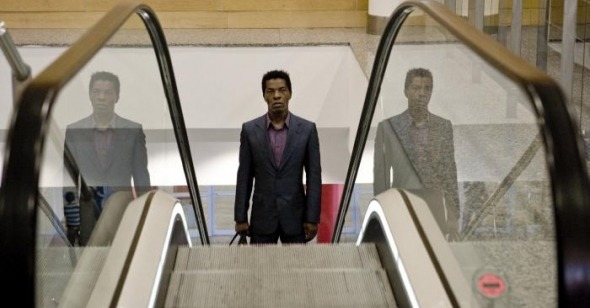Mission Impassable
by Michael Koresky
The Limits of Control
Dir. Jim Jarmusch, U.S., Focus Features
Is the beginning even the beginning? It‚Äôs a question I posed in my head about halfway through Jim Jarmusch‚Äôs The Limits of Control, first literally and later philosophically. Structured as a series of discrete, uncannily repeated sit-down encounters between a mysterious loner (Isaach De Bankol√©) on some sort of criminal assignment and a succession of enigmatic oddball contacts throughout sunny Spain, The Limits of Control at least seems to have a concrete starting point: De Bankol√©‚Äôs airport rendezvous with a Creole and French man (Alex Descas and Jean-Fran√ßois St√©venin), who appear to be giving him his initial coordinates, albeit in subtitled French and then spoken English (just the first instance of repeated information in a film that continues to replicate itself throughout). But the more narratively obscured, morally ambiguous meetings he has, and the more they echo one another in increasingly apparent ways, the more I began to assume that not only might the film‚Äôs purpose and ‚Äúlogical‚ÄĚ endpoint remain unrevealed but also that perhaps we began this story in medias res. That we never find out only adds to the teasing, circular existentialism of Jarmusch‚Äôs film, his best in over a decade. It‚Äôs a return to the subliminally jokey neonoir of some of his early films, but it‚Äôs also unmistakably the work of a seasoned master who understands the power of every shot, cut, and uttered word.
The Limits of Control finds Jarmusch in laidback self-reflexive mode‚ÄĒthe structure is circular, even if the film itself is made up of sharply defined, harsh angles and straight lines. Like its protagonist, it‚Äôs wholly ascetic, yet a distinctly Jarmuschian brand of tomfoolery pokes around the edges of its modernist cleanliness. During the course of his mission (undefined to us, though in all likelihood clear as crystal to him), De Bankol√©‚Äôs taciturn lone man travels from Madrid to Seville, and ends up in the desert, though all his destinations fuse together and overlap, marked as they are by the same tokens and talismans: Le Boxeur matchbooks passed to him over tabletops, tiny paper notes showing indecipherable symbols (coordinates?) that he promptly swallows with a swig of one of the two espressos he continually orders (‚Äúin separate cups!‚ÄĚ he demands, in one of the few lines he utters in the film). The destination and goal are never betrayed; Jarmusch remains as uncommunicative as De Bankol√©, whose sculpted facial features barely move a millimeter from first frame to last (there‚Äôs just the faintest trace of a smile at a joke made by contact John Hurt). He‚Äôs Le Samourai‚Äės Alain Delon reimagined as a newly global ghost, unburdened by identity or specific nationality.
Stoic and smooth, attractively bow-legged in his glistening silvery-blue suits, this protagonist exists out of time‚ÄĒa possible Luddite, maybe a Buddhist, but definitely an aesthete. Every twist in his assignment is marked by long passages of waiting, in which he traverses sun-dappled squares and lies in wait in hotel rooms‚ÄĒyet he often makes room for museum visits, returning regularly, in between his cryptic meetings, to Madrid‚Äôs Museo Nacional Centro de Arte Reina Sofia. Like Vertigo‚Äôs Madeleine staring at the painting of sad Carlotta, De Bankol√© seems to be immersing himself in art, on each visit fixating on an image that somehow echoes the latest clue of his mission‚ÄĒwhile waiting for a man with a violin case he soaks in Juan Gris‚Äôs cubist ‚ÄúLe violin‚ÄĚ; before meeting a mysterious woman (Paz de la Huerta) lying naked on his hotel room bed, with whom according to instructions he must wait, he admires a supine nude by Roberto Fernandez Balbuena. There‚Äôs nothing literal going on here, no plot-driving hints hidden behind the frames or scrawled on the canvases, Da Vinci Code-style; rather Jarmusch seems to be engaging us in both his protagonist‚Äôs world view (quietly artistic, meditative) and in the practice of viewing the universe aesthetically, as well as morally. Each contact that the lone man meets along the way (Tilda Swinton, looking in her bleach-white raincoat and wig as though eloped from Pee Wee‚Äôs Playhouse; a denim-clad, hirsute Gael Garc√≠a Bernal; a glistening Youki Kudoh, ever melancholy) seems locked in a stranglehold of philosophy, spouting provocations like ‚ÄúEverything is subjective,‚ÄĚ ‚ÄúReality is arbitrary,‚ÄĚ and ‚ÄúNothing is true.‚ÄĚ Thus, while watching the film, our craving for narrative justification becomes synonymous with Jarmusch‚Äôs philosophical quest. Ultimately there‚Äôs nothing new here: just the age-old dead end of the search for knowledge.
If that makes the film sound like a metaphysical slog, it’s surely anything but. Christopher Doyle’s refined, yet continuously surprising cinematography (the camera always seemed to either stay still or move when I least expected it) and the music by Japanese experimental trio Boris, which at times attains a Kubrickian abstract grandeur, keep every moment vital and enveloping. Like his poetic Western Dead Man (one of the very best films of the Nineties), Jarmusch keeps The Limits of Control smartly, if tensely, balanced between matters of existence and those of genre filmmaking. It’s less a willfully obscure puzzle movie than a careful description of the world refracted in art (Rimbaud, Burroughs, Gris, Kaurismäki, Hitchcock). And that likewise, as indicated in the film’s opening image, of De Bankolé meditating in a bathroom, his tai chi moves distorted and upside down in a mirror, art is merely a funhouse reflection of reality.
